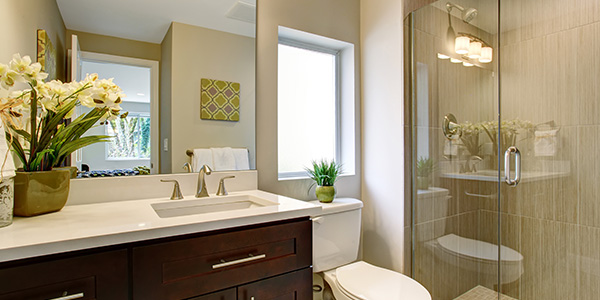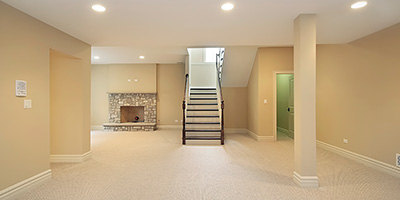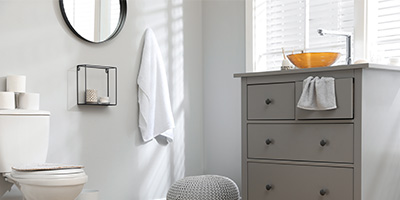How to Plan Your Home Renovation Costs

How to Budget for a Home Renovation
Sticking to a budget is always a challenge. Creating a budget for a large project you’ve never done before is an even bigger challenge. When it comes to remodeling costs, building a reasonable home renovation budget requires a detailed plan and plenty of research.
Fortunately, we've done most of the leg work for you. Simply follow the steps below to create a remodeling budget that will keep you from overspending on your next renovation.
How Much Does It Cost to Remodel a House?
According to HomeAdvisor, the average home renovation cost is approximately $49,979. The amount you spend is largely determined by the size of your space. Renovations made to an older home tend to cost more than a newer one, especially if the wiring, plumbing and other features aren’t up to code. For this reason, you can expect to pay anywhere from $10 to $150 per square foot of your home.
When you’re deciding on your home renovation budget, it can be easier (and more affordable) to prioritize projects by room and build a budget around the cost of each individual project.
Room: | Renovation cost: |
|---|---|
Bathroom | $3,000-$25,000 |
Home office | $5,000+ |
Living room | $5,000-$10,000 |
Kitchen | $6,000+ |
Utility room | $6,000+ |
Master bedroom | $10,000-$15,000 |

How Do I Estimate My Home Renovation Costs?
To get an approximate idea of what your remodeling budget should be, consider the value of your home as a whole. You don’t want to spend more than 10 to 15 percent of your home’s value on a single room. If you spend more, the value of the renovation will not proportionally add to the value of your home.
For example, if your home is worth $100,000, the maximum you should spend on a kitchen or bathroom renovation is $15,000. If your home is worth more, the cost to remodel your house will probably be higher.

“Most of the time, it’s really hard for a homeowner to know where to start. I recommend bringing in a design build contractor early on in the process. In their initial consultation they can talk about your needs and priorities and help guide you through a project that is realistic for your budget.”
Danny Niemela | ArDan LLC
Figure Out Financing Before You Build a Remodeling Budget
Not sure how to budget for a home renovation? First, you’ll need to determine how you’re financing it. If you are paying in cash, taking out a loan or applying for credit, your remodeling budget must fit within the limit of your available funds.
Once you know how much you can afford to spend, set aside 10 to 20 percent of your available funds for unexpected expenses. This is important. It’s not uncommon for something to go wrong or cost more than originally projected. By setting aside a percentage before starting your remodel, you know you’ll have the funds available to finish your project no matter what happens.

“Managing money is determined by the decisions you make for your project. Ask yourself what is most important to you by prioritizing your needs before getting started. Getting family members on the same page will be critical prior to starting the project.”
Elizabeth Dodson | Co-Founder, HomeZada
Financing Options to Consider
Here are a few ways you can finance your home renovation, according to NerdWallet:
- Home equity loan or line of credit. A home equity loan or line of credit lets you borrow up to 85% of your home’s value, not including what you already owe. If you opt for the line of credit, you can borrow what you need, and only pay interest on what you take out. If you opt for a home equity loan, the bank will give you a lump sum which you’ll usually have to repay in 15 years or less.
- Cash-out refinance. This financing option replaces your current mortgage with a larger one. The balance on your previous mortgage is paid to you in cash, which you can use to fund your remodeling projects.
- Personal loans. This type of loan lets you complete your home remodel faster, as most lenders can fund it in just a few days, but its good to know that these loans usually carry much higher interest rates.
- Cash. Paying in cash is the most desirable way to finance your home renovation, as you’ll complete your remodeling project without accumulating interest.

“I recommend setting aside between 10 to 20 percent for a cushion. If you hire the right contractor to do some exploratory demolition or investigative work early on there should be very little unforeseen work that needs to happen. However, in our experience once a project starts many of our clients pull out the ‘While you are here, can you also do...’ list and if a client has the money set aside, we can easily accommodate it during the duration of the project.”
Danny Niemela | ArDan LLC
Tips for Cutting House Renovation Costs
While setting your remodeling budget, use these tips to save even more money on your home renovation:
- Complete demolition yourself: If you’re removing cabinets or pulling up tile as part of your renovation, consider doing the work yourself. As long as there is no expertise required, this is a good way to reduce labor costs and save a few dollars.
- ** Order fixtures and finishes yourself:** Your contractor will probably charge you an hourly fee to do your shopping for you and may even charge a markup. Be clear about your plans so your contractor knows you’re taking on that responsibility yourself.
- Be your own project manager: If you need to hire additional subcontractors for your project, interview and select them yourself instead of having your general contractor do it.
- Do your own painting: Having a room painted by a professional can cost $300 or more. Plan to complete any required painting yourself and you can remove that cost from your remodeling budget.
- Shop used: Instead of purchasing everything brand-new, pick up used or refurbished items when possible. This can greatly reduce your spend on appliances and finishes.
Once you’ve decided how much you’re going to spend, use the following steps to create a detailed plan and remodeling budget.
Steps for Making a Detailed Home Renovation Budget
1. Decide What’s Most Important to You in Your Remodel
The easiest way to stick to your remodeling budget is to know exactly what you want. Create a list of everything you’d like the project to include and separate these items into wants and needs.

“Think about the proper order to do things in. It makes no sense to get new kitchen counters if you know that later on you’ll likely need to upgrade your cabinets or change the floor plan, right? Doing things in the right order saves time and money in the long run.”
Christine White | The (mostly) Simple Life
Ask Yourself These Questions:
- What do you want this project to do?
- What details are required to make that happen?
- What are you willing to compromise on?
- What are you willing to splurge on?

2. Keep a List of All Your Cost Estimates
After setting the goal for your home renovation, create a detailed plan that includes expected costs. This will help you build a remodeling budget and communicate exactly what you want with your contractors.
Build a spreadsheet that includes each portion of the project and the estimated cost for labor and materials. To develop cost estimates:
- Use resources like HomeAdvisor to estimate labor costs for engineers, architects, plumbers and handymen. Labor usually accounts for 20 to 35 percent of a project’s budget.
- Choose fixtures and finishes and calculate what you will spend on them. Include paint, knobs, faucets, tile, flooring and anything else you’ll need. Don’t forget to include taxes and shipping costs in the estimates for your materials.
- Include the appliances you want and what you expect to spend on them. Include costs for installation, delivery and how you plan to dispose of appliances.
- Consider what living expenses you will incur during your project. Consider the costs for living without a functioning kitchen, boarding pets or staying outside the home during your project and include these costs in your spreadsheet.
If you can create a plan that is detailed enough and includes your choice of finishes and fixtures, your conversations with contractors can focus purely on labor costs and time estimates.

“Don’t forget to budget for small things. You may need paint brushes, tape, sandpaper, drop cloths, hand tools, and other supplies. While none of those costs too much, they can easily add up to $100 or much more when you need a bunch of random little things.”
Christine White | The (mostly) Simple Life

3. Request Bids From Multiple Contractors
Now you know what you need, what you want and what you can afford to pay for each item. It’s time to find a contractor that can complete your project within your home remodeling budget.
Search for local companies with good reviews and ask them to create a bid for your project. We recommend getting bids from at least three companies so you can accurately compare the costs.
When Choosing a Contractor:
- Complete interviews and check their references.
- Be very clear about both your project and your remodeling budget. If your contractor knows you’re sticking to a tight budget, they will be more likely to talk through additional expenses, time delays and project changes with you.
- Make sure the contractor thoroughly understands your needs and has a clear idea of how you plan to prioritize parts of the project.
- Talk through how you will approach any unforeseen issues and how it will affect the budget of the project.
How to Narrow Down Your Contractor List
You might find several contractors who would be a good fit for your project. Use the following tips to narrow down your list:
- Don’t fall for cheap labor. If one contractor’s bid is well below the others, toss it out. Cheap labor sounds appealing, but it opens the door to errors which can cost you more money later. Use competing bids to negotiate with your preferred contractor.
- Consider your wants and needs. If none of the contractor estimates fit into your remodeling budget, cut down on the project until you’re comfortable with the cost. Use your list of wants and needs to eliminate parts of the project you previously deemed less important.
- Read online reviews. Always look at a contractor’s reviews before hiring them for your project. Don’t make your project more difficult and expensive by failing to check Yelp or Google Reviews.
Once you’ve selected your contractor, ask them to look at your project plan and home renovation budget to see if there are any costs you may have overlooked. Use the contractor’s estimate as well as feedback to make a final update to your project plan before beginning work to make sure the final project stays on budget.

4. Schedule Your Renovation
The season you complete your home remodel also affects how much you spend. According to Angi, summer is the most popular time of year to renovate your house. This is because you can only complete certain projects during the warmer months, such as installing new windows or building a new deck. But if you’re only remodeling your home’s interior, making these updates during the winter can help you save money.
Things to Consider at the Time of Your Remodel
- Summer: Contactors are in high demand, often driving up home renovation costs.
- Spring: A more expensive time to renovate your home, as the weather is decent but the days aren’t as long as they are in the summer.
- Fall: While temperatures aren’t frigid just yet, thunderstorms and rain can hinder outdoor projects. For this reason, house renovation costs aren’t as expensive as they are in the summer.
- Winter: The most budget-friendly time to renovate your home. However, you can’t complete many outdoor projects due to snow and colder temperatures.

“It’s important to look at your cash flow and project type before deciding when you should complete your home remodel. However, every homeowner can plan for their project in advance. By using a remodel tracking solution like HomeZada, you can prepare for your remodel with selections, managing tasks, and creating budgets. Taking and storing before photos is also valuable prior to getting started on your home renovation.”
Elizabeth Dodson | Co-Founder, HomeZada


